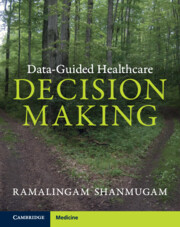Book contents
- Data-Guided Healthcare Decision-Making
- Data-Guided Healthcare Decision-Making
- Copyright page
- Dedication
- Contents
- Figures
- Tables
- About the Author
- Preface
- Glossary
- Notations and Symbols
- Prologue
- Introduction
- Chapter 1 Why and How Healthcare Decisions Are Made
- Chapter 2 Are Data-Guided Healthcare Decisions Superior?
- Chapter 3 Software
- Chapter 4 How to Collect Authentic Data
- Chapter 5 Uncertainties and Their Impact on Healthcare Decisions
- Chapter 6 Why Models Are Important in Healthcare
- Chapter 7 How Healthcare Decision Trees Emerge and Function
- Chapter 8 How Are Group Decisions Practiced in Healthcare?
- Chapter 9 Tracing and Remedying Root Causes of Adversities
- Chapter 10 Healthcare Decision-Making for Cost-Effectiveness
- Chapter 11 Risk Analysis in Healthcare Decision-Making
- Chapter 12 Evaluation of Healthcare Programs
- Chapter 13 Six Sigma and Lean Management in Healthcare Sectors
- Chapter 14 Forecasting in Healthcare Sectors
- Epilogue
- Appendix Statistical Tables
- Index
- References
Chapter 2 - Are Data-Guided Healthcare Decisions Superior?
Published online by Cambridge University Press: 13 July 2023
- Data-Guided Healthcare Decision-Making
- Data-Guided Healthcare Decision-Making
- Copyright page
- Dedication
- Contents
- Figures
- Tables
- About the Author
- Preface
- Glossary
- Notations and Symbols
- Prologue
- Introduction
- Chapter 1 Why and How Healthcare Decisions Are Made
- Chapter 2 Are Data-Guided Healthcare Decisions Superior?
- Chapter 3 Software
- Chapter 4 How to Collect Authentic Data
- Chapter 5 Uncertainties and Their Impact on Healthcare Decisions
- Chapter 6 Why Models Are Important in Healthcare
- Chapter 7 How Healthcare Decision Trees Emerge and Function
- Chapter 8 How Are Group Decisions Practiced in Healthcare?
- Chapter 9 Tracing and Remedying Root Causes of Adversities
- Chapter 10 Healthcare Decision-Making for Cost-Effectiveness
- Chapter 11 Risk Analysis in Healthcare Decision-Making
- Chapter 12 Evaluation of Healthcare Programs
- Chapter 13 Six Sigma and Lean Management in Healthcare Sectors
- Chapter 14 Forecasting in Healthcare Sectors
- Epilogue
- Appendix Statistical Tables
- Index
- References
Summary
First, let us examine why decisions become more authentic and accurate when they are based on evidence. Not all healthcare professionals are convinced data-based decision-making is prudent. To make such decision-making feasible, knowledge of data collection and its analysis is a necessity. Analysts help decision makers handle these complex technicalities. Rarely does a decision maker encounter only one technicality. Consequently, the decision maker may need more than one analyst.
How do we define an analyst? An analyst has the expertise and the knowledge base to study the available information and to understand the choices in front of the decision maker along with the consequences of each.
How do we define the healthcare administrator as a decision maker? The healthcare decision maker has the responsibility to make the best decision in his or her healthcare practices.
- Type
- Chapter
- Information
- Data-Guided Healthcare Decision Making , pp. 9 - 54Publisher: Cambridge University PressPrint publication year: 2023



